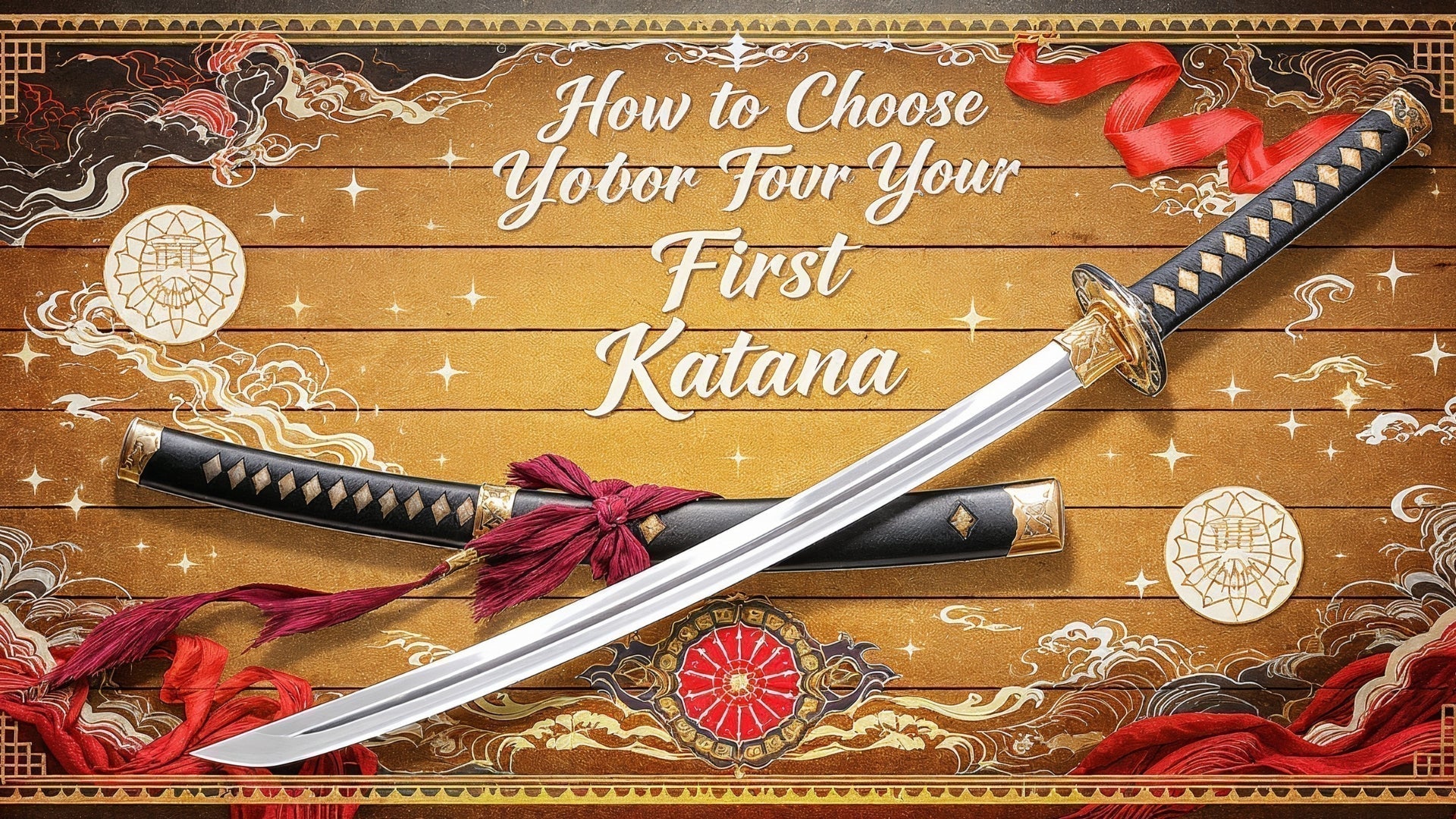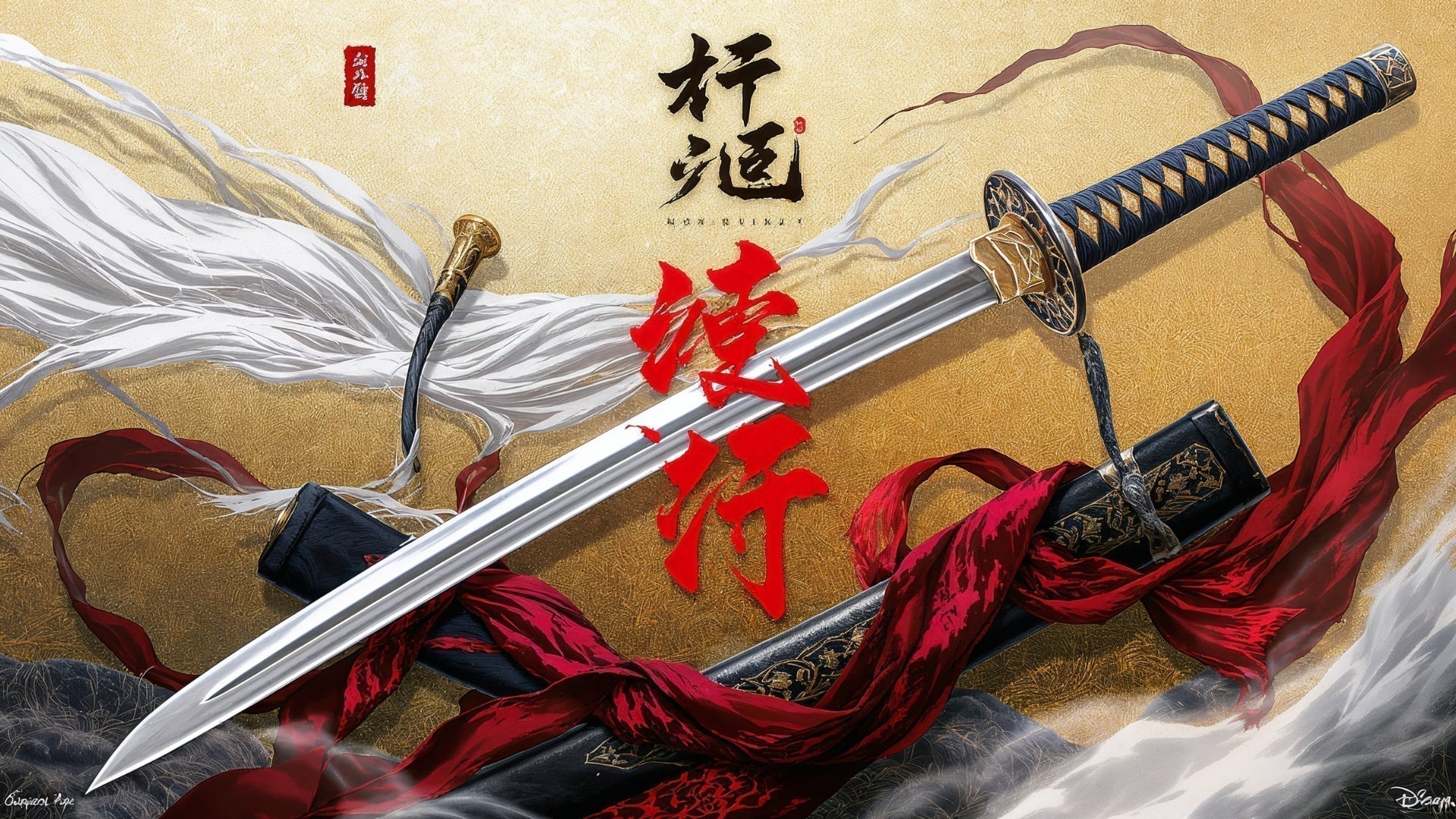The katana is more than just a sword, it is a cultural icon, a symbol of the samurai’s soul, and one of the most recognizable weapons in history. But for someone new to Japanese swords, buying a first katana can be overwhelming. With countless options ranging from cheap replicas to handmade works of art, how do you know which one is right for you? This comprehensive guide will walk you through everything you need to know: from types of katanas and steel choices to length, fittings, budget, legality, and maintenance. By the end, you’ll be ready to make an informed decision about your first katana.
History of the Katana: Why It Still Matters Today
The katana was not always the primary weapon of the samurai. During Japan’s Heian and Kamakura periods, the tachi and naginata dominated the battlefield. It wasn’t until the late Muromachi period (14th–16th centuries) that the katana became the samurai’s signature sword. Worn edge-up and designed for fast draws, it suited the evolving demands of combat in increasingly urban and castle-centered warfare.
Even today, the katana remains deeply significant. Martial artists study its techniques, collectors treasure its craftsmanship, and popular culture immortalizes it in film, anime, and literature. For beginners, choosing a katana is not just buying a blade—it’s participating in a tradition stretching back centuries.
Understanding the Different Types of Katana
Not all katanas are created equal. Broadly speaking, katanas fall into three categories:
Decorative Katana
-
Often made of stainless steel.
-
Inexpensive ($50–$200).
-
Designed for display only, not for use.
-
Heavy and unbalanced, with welded or weak tangs.
-
Good if you want a wall-hanger, but unsafe for practice.
Functional Katana (Shinken or Iaitō)
-
Forged from high-carbon steel.
-
Can be sharpened (shinken) or blunt (iaitō for martial arts training).
-
Prices range from $300–$2,000.
-
Perfect for cutting practice (tameshigiri) or martial arts forms.
Traditional Japanese Katana (Nihontō)
-
Hand-forged in Japan by licensed smiths.
-
Made using tamahagane steel and traditional methods.
-
Limited production, heavily regulated.
-
Extremely expensive ($5,000–$50,000+).
-
Considered works of art and cultural treasures.

Understanding Katana Construction
A beginner should also understand how katanas are built:
-
Maru construction: Single piece of steel, affordable and common.
-
Kobuse: Hard steel jacket around a softer core, balancing strength and flexibility.
-
Sanmai: Three-layer construction, with hard edge steel sandwiched between softer sides.
-
Shihozume: Complex four-sided construction, rare and expensive.
While most entry-level functional katanas are maru, higher-end models use kobuse or sanmai for durability. For your first katana, a simple but solid maru or kobuse blade is sufficient.
Choosing the Right Steel
Steel quality determines the katana’s strength, sharpness, and durability.
-
1045 Carbon Steel: Entry-level, affordable, good for light cutting.
-
1060 Carbon Steel: Better balance of hardness and flexibility, great for beginners.
-
1095 Carbon Steel: Very hard, razor-sharp, but less forgiving to mistakes.
-
Spring Steel (5160, 9260, T10): Highly durable, flexible, ideal for heavy cutting.
-
Tamahagane Steel: Traditional Japanese steel, rare and expensive.
If you’re new, a 1060 or 9260 steel katana offers excellent value and resilience.

Balance, Geometry, and Blade Shapes
The geometry of a katana influences how it feels in the hand and how it cuts.
-
Shinogi-zukuri: The most common blade shape, with a ridge line that balances strength and sharpness.
-
Hira-zukuri: Flat blade without a ridge, lighter but less durable.
-
Kissaki types: The tip of the blade varies (ō-kissaki = long tip, chu-kissaki = medium tip). Beginners often do best with a chu-kissaki, as it is more forgiving.
Balance is also key. A well-balanced sword should feel like an extension of your arm, not a heavy stick.
Length, Weight, and Balance
Choosing the right size is essential for safety and comfort.
-
Standard katana blade length: 70–74 cm (27–29 inches).
-
Handle (tsuka): 25–30 cm (10–12 inches).
-
Average weight: 1.1–1.3 kg (2.4–2.8 lbs).
Tip for beginners: If you’re shorter, go for a slightly shorter blade for better control. Martial arts schools often recommend matching the blade length to your arm span.

Training vs Display: Choosing Based on Purpose
Your purpose determines what kind of katana you should buy:
-
Training: Go for a blunt iaitō or a durable shinken made of 1060/9260 steel.
-
Tameshigiri (cutting practice): Look for through-hardened or clay-tempered blades with good balance.
-
Display/Cosplay: Decorative swords are fine, but unsafe for cutting.
-
Collecting: Nihontō or high-end reproductions.
Understanding your purpose avoids disappointment or dangerous mistakes.
Fittings and Mountings: More Than Decoration
A katana isn’t just about the blade. The fittings (koshirae) affect both function and appearance.
-
Tsuka (handle): Wood core, wrapped in rayskin and silk or cotton.
-
Tsuba (guard): Protects the hand, often decorative.
-
Saya (scabbard): Lacquered wood, sometimes ornamented.
-
Ito (wrap): Provides grip; silk is traditional, cotton more affordable.
Quality fittings ensure safety. A loose tsuka or poorly fitted tsuba can make a katana dangerous to use.
Budget: How Much Should You Spend?
Here’s a general breakdown of katana price ranges:
| Category | Price Range | Quality / Use Case |
|---|---|---|
| Decorative Katana | $50–$200 | Wall display, cosplay |
| Entry-Level Shinken | $300–$600 | Light cutting, beginner practice |
| Mid-Range Functional | $600–$1,500 | Martial arts training, tameshigiri |
| High-End Functional | $1,500–$3,000 | Collectors, advanced practitioners |
| Nihontō (Japan-made) | $5,000–$50,000+ | Art pieces, national treasures |
For a first real katana, aim for the $300–$1,000 range. This ensures both safety and quality.

Beginner Mistakes to Avoid
-
Buying a stainless steel “battle-ready” sword (unsafe).
-
Ignoring fittings—poor construction is dangerous.
-
Choosing a blade that’s too long or heavy.
-
Skipping research and impulse buying.
-
Overpaying for “custom” decorative pieces marketed as functional.
Red Flags When Buying a First Katana
-
Vague product descriptions with no steel type listed.
-
Sellers using only stock photos.
-
Unrealistically cheap “real battle-ready” claims.
-
Hamon lines that are etched, not real (fake tempering).
-
Blades with welded tangs or rat-tail tangs.
Always check for full tang construction, detailed specifications, and reputable sellers.
Safety and Legality
Before buying, check the legal status of katanas where you live:
-
USA: Legal in most states, restrictions on carrying in public.
-
UK: Functional curved swords over 50 cm are restricted unless hand-forged or antique.
-
EU: Varies by country—often legal to own, restricted to carry.
-
Japan: Strict regulations; only licensed smiths may produce nihontō.
Always verify local laws. And remember: a katana is not a toy. Even unsharpened blades can cause serious injury.
How to Care for Your First Katana
A katana requires maintenance to preserve its beauty and function.
-
Clean the blade with uchiko powder or a soft cloth.
-
Apply light oil (choji or mineral oil) to prevent rust.
-
Store in a dry place, inside its saya.
-
Never touch the blade with bare fingers (oils cause corrosion).
-
Periodically check the fittings for looseness.
Proper care ensures your katana lasts for generations.

Beginner Case Studies
-
Martial Artist: Chooses a 1060 steel iaitō for practice. Learns kata safely before transitioning to a sharpened blade.
-
Collector: Buys a mid-range functional katana with artistic fittings. Plans to expand collection gradually.
-
Cosplayer: Chooses a decorative katana with flashy fittings for conventions but avoids real cutting.
These examples show how needs differ, and why clarity of purpose matters when choosing.
Beginner Training Recommendations
If your goal is to train in martial arts, your first katana should align with your discipline:
-
Iaido: Start with a blunt iaitō for learning safe draws and kata.
-
Kendo: Focuses on shinai (bamboo swords), but knowing katana specs helps transition to iaido or battōdō.
-
Battōdō/Tameshigiri: A functional shinken with durable steel (1060 or 9260) is ideal for cutting rolled mats.
Training with the wrong type of sword can be unsafe and hinder progress.
Accessories and Essentials for Beginners
Buying a katana is just the first step. Beginners should also consider:
-
Maintenance kit: Includes uchiko ball, oil, cloth, and mekugi-nuki.
-
Sword stand (Katanakake): For safe display.
-
Storage bag: Protects the saya and blade during transport.
-
Tatami mats or water bottles: For supervised cutting practice.
These small investments make ownership safer and more rewarding.
Where to Buy Your First Katana
Trusted options include:
-
Specialized online shops: Katana-Corp, Swords of Northshire, Tozando.
-
Reputable forges: Longquan (China), licensed smiths in Japan.
-
Martial arts suppliers: Stores specializing in iaidō or kendō equipment.
Avoid cheap listings on marketplaces with vague descriptions. Look for detailed specifications, real photos, and customer reviews.

Extended FAQ: Choosing Your First Katana
What’s the best steel for beginners?
1060 or 9260 carbon steel balances durability and price.
Should I buy a sharpened katana as my first?
Not unless you’re supervised. Start with an iaitō or unsharpened blade.
Is a custom katana worth it for beginners?
No—focus on functionality and safety before aesthetics.
Can I practice with a decorative katana?
Never. They are unsafe and not designed for use.
How do I know if a seller is reputable?
Check reviews, certifications, and detailed product descriptions.
How much should I spend on my first katana?
Around $300–$800 is ideal for a safe, functional starter blade.
Are katanas legal everywhere?
No, always check your local laws before buying.
What size katana should I get?
Match blade length to your arm span for balance and safety.
Do I need to oil my katana?
Yes, to prevent rust. Light oiling after use is essential.
Can I use my katana for cutting right away?
Only after proper training. Improper use can damage the sword—or you.
What is the difference between clay-tempered and through-hardened blades?
Clay-tempered blades have visible hamon and balance hardness/flexibility. Through-hardened are tougher but less traditional.
What is a full tang?
A blade that extends fully through the handle, ensuring durability. Essential for functional swords.
Why are nihontō so expensive?
They are handmade in Japan using rare tamahagane steel and centuries-old methods, with strict regulations.
Do women practice with katanas today?
Yes, women actively participate in kendō, iaidō, and other martial arts using katanas.
What accessories should I buy with my first katana?
A maintenance kit (oil, uchiko, cloth), a proper stand, and a storage bag.
How do I know if the hamon is real?
Real hamon are created during differential hardening; etched ones look too uniform and lack depth.
Can I sharpen my katana at home?
Not recommended. Professional polishing is the safest way.
How do I safely transport a katana?
Always keep it in a saya and carry it in a bag designed for swords.
What’s the difference between iaitō and shinken?
Iaitō are blunt training swords; shinken are sharp, functional swords for cutting practice.
Can body size affect katana choice?
Yes, shorter practitioners benefit from shorter blades for control; taller individuals may prefer longer blades.
Conclusion: Choosing Your First Katana with Confidence
Buying your first katana is an exciting journey. By understanding the types, steels, construction, fittings, and price ranges, you’ll avoid costly mistakes and find a sword that suits your needs. Whether you’re drawn by martial arts, history, or simple admiration for Japanese culture, your first katana will be more than a blade—it will be a connection to centuries of craftsmanship and warrior spirit.



Share:
Katana vs Tachi: Understanding the Ancestry of the Samurai Sword
Are Katanas Battle Ready? Functional vs Decorative Blades